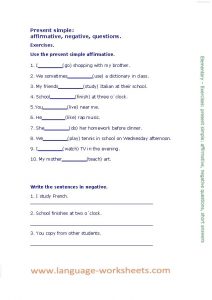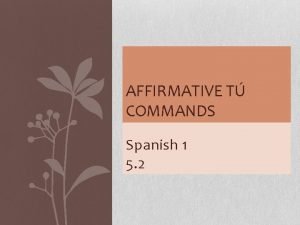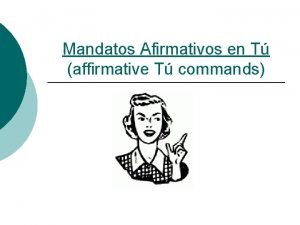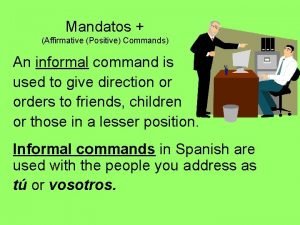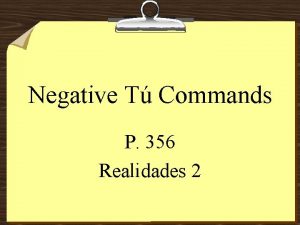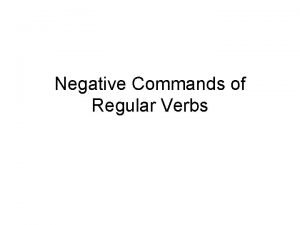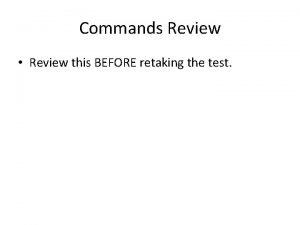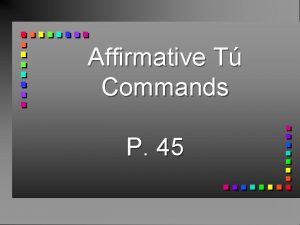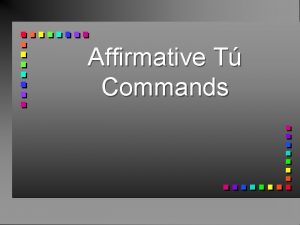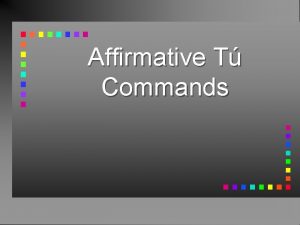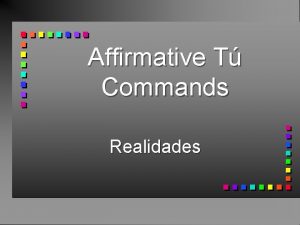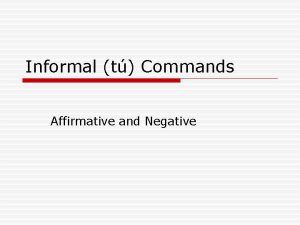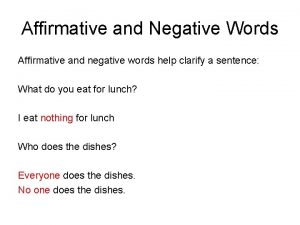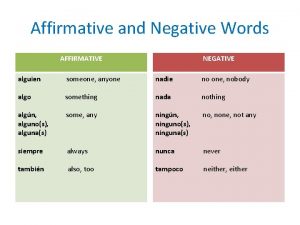Affirmative and Negative t commands To form an




















- Slides: 20

Affirmative and Negative tú commands

To form an affirmative “tú command” or to tell someone what to do… rd 3 Use the person singular form of the verb.

caminar (tú) caminas ¡camina! (él/ella form) comer (tú) comes ¡come! (tú) escribes ¡escribe! (él/ella form) escribir (tú) escribes (él/ella form)

Carmen, ¡lava los platos! ¡Saca la basura! ¡Come las legumbres! ¡Escribe tu nombre!

1. Speak Spanish Habla español 2. Take out the trash Saca la basura 3. Read this book Lee este libro 4. Play with your brother Juega con tu hermano 5. Open the gift Abre el regalo

To form a negative “tú command” or to tell someone not to do something… Start by writing the word “no” Then conjugate the verb in the ‘yo’ form. Drop the ‘o’. If it is an –ar verb, add ‘-es’. If it is an –er / -ir verb, add ‘-as’. Ex. Conducir: (yo) No conduzco→ No conduzcas

caminar (yo) camino comer (yo) como escribir (yo) escribo camines ¡No camines! como ¡No comas! comas escribo escribas ¡No escribas!

¡Ejemplos! • Don’t speak! ¡No hables! • Don’t eat! ¡No comas! • Don’t sleep! ¡No duermas!

There are 8 irregulars in the affirmative. poner pon tener ten decir di salir ven hacer haz ser sé ir ve

There are 5 negative irregulars: dar estar ir saber ser No des No estés No vayas No sepas No seas

1. Do your homework. Haz la tarea. 2. Be careful. Ten cuidado. 3. Put the books on the table. Pon los libros en la mesa. 4. Don’t leave at 3: 00. No salgas a las tres.

5. Drive slowly. Maneja despacio. 6. Don’t stop at the stoplight. No pares en el semáforo. 7. Don’t go to the corner. No vayas a la esquina. 8. Cross the street. Cruza la calle. 9. Be patient. Sé paciente.

10. Turn to the left. Dobla a la izquierda. 11. Tell the truth. Di la verdad. 12. Continue straight. Sigue derecho. 13. Return the book. Devuelve el libro. 14. Come here. Ven aquí.

CAR/GAR/ZAR endings with Negative commands • car becomes –ques • gar becomes –gues • zar becomes -ces When using ONLY the negative commands!!!

Ejemplos con car / gar/ zar Affirmative Negative cruzar cruza No cruces practicar practica No practiques dedicar dedica No dediques memoriza No memorices paga No pagues memorizar pagar

Práctica con car/gar/zar Traduce las frases: 1. Don’t arrive on time! ¡No llegues a tiempo! 2. Don’t look for the tire! ¡No busques la llanta! 3. Don’t explain the file! ¡No expliques el archivo! 4. Don’t start the blog! ¡No empieces el blog!

Atención- when a reflexive, DOP or IOP is used with commands • For positive commands, pronouns are attached to the end of the command. -dame (Give me) -hazlo (Do it) • For negative commands, the pronouns go after the no and before the verb. No me hables. / Don’t talk to me. No la comas. / Don’t eat it. (the apple) • Accents need to be placed on affirmative commands that are more than 2 syllables. Count back 3 syllables and place the accent on the vowel. Ex. Help him - ayúdalo 3 2 1

With DOP’s Rewrite the following sentences, replacing the noun in italics with the appropriate direct object pronoun. Ex. Ayuda a Marta. Ayúdala 1. Haz la tarea. Hazla 2. Espera a tus amigos. Espéralos 3. Deja el coche en el garaje. Déjalo 4. Di la verdad. Dila 5. Pon el mapa en la mesa. Ponlo 6. Escucha las canciones de Beyoncé. Escúchalas

With IOP’s Translate the following sentences using the appropriate indirect object pronoun. Ex. Tell him the truth. Dile la verdad (a él). 1. 2. 3. 4. 5. 6. Give him the printer. Dale la impresora (a él). Tráeme el carro (a mí). Bring me the car. Leave her the keys. Déjale las llaves (a ella). Send me the screen. Mándame la pantalla (a mí). Talk to him about the trunk. Háblale sobre el baúl (a él). Teach her to drive. Enséñale a manejar (a ella).

With Reflexives Translate the following sentences using the appropriate reflexive pronoun. Ex. Brush your teeth. Cepíllate los dientes. 1. Put on makeup. Maquíllate 2. Don’t get up. No te levantes. 3. Don’t wash your hair. No te laves el pelo. 4. Get dressed. Vístete 5. Don’t wake up. No te despiertes. 6. Wash your hands. Lávate las manos.
 Affirmative form negative form interrogative form
Affirmative form negative form interrogative form Dos commands internal and external
Dos commands internal and external Present simple negative questions exercises
Present simple negative questions exercises Simple present affirmative examples
Simple present affirmative examples Capitulo 3b irregular affirmative tu commands
Capitulo 3b irregular affirmative tu commands Study spanish informal commands
Study spanish informal commands Affirmative commands in spanish
Affirmative commands in spanish Affirmative commands in spanish
Affirmative commands in spanish Affirmative informal
Affirmative informal Infinitive of digo
Infinitive of digo Mandatos afirmativos con tú (p 121)
Mandatos afirmativos con tú (p 121) Sacar tu command
Sacar tu command Negative informal commands spanish
Negative informal commands spanish Affirmative formal command
Affirmative formal command Affirmative commands
Affirmative commands Comer afirmativo
Comer afirmativo Affirmative familiar commands
Affirmative familiar commands 8dar8
8dar8 Appropriate negative
Appropriate negative Car gar zar negative tu commands
Car gar zar negative tu commands Negative familiar commands in spanish
Negative familiar commands in spanish


